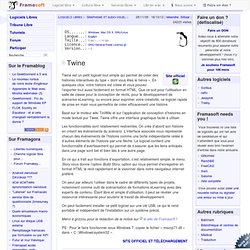

Twine - Bureautique. Twine est un petit logiciel tout simple qui permet de créer des histoires interactives du type « dont vous êtes le héros ».

En quelques clics, votre histoire est créée et vous pouvez l’exporter tout aussi facilement en format HTML. Que ce soit pour l’utilisation en salle de classe pour la conception de récits, pour le développement de scénarios eLearning, ou encore pour exprimer votre créativité, ce logiciel rapide de prise en main vous permettra de créer efficacement une histoire. Basé sur le moteur wiki TiniWiki et sur l’application de conception d’histoires en mode textuel pur Twee, Twine offre une interface graphique facile à utiliser.
Les fonctionnalités sont relativement restreintes. On crée d’abord son histoire en créant les événements du scénario. On peut par ailleurs l’utiliser dans le cadre de différents types de projets, notamment comme outil de scénarisation de formations eLearning avec des experts de contenu. Vous souhaitez mettre à jour la notice ? Write 'Choose Your Own Adventure' Books Through This Clever HTML5 App. Who hasn’t, at least for a moment, thought a Choose Your Own Adventure book would be fun to write?

It’s like making a game out of words. Branching narratives are a surprisingly natural approach to make books interactive. But they’re a logistical nightmare. Multiple storylines? Converging plots? A company called inkle appears to have figured it out. Now, inkle is making their internal compositional software available to the public free as an HTML5 web app called inklewriter. “We’re trying to get people into the mode of ‘just writing,' and not thinking about story graphs and stuff like that,” Creative Director Jon Ingold tells Co.Design.
It really is quite simple. By clicking on the apple pie option, you can continue your narrative explaining that the ghost was really just misunderstood, all while inventing some sort of fictional physics that makes a ghost able to chew corporeal food. It’s a good lesson in UI design. Try it here. [Image: Yuriy Cherlok/Shutterstock] Inklewriter. Story Starters. Mashing Up the Web: Bo.lt- A Disruptive Tool for Educators? The other day, someone reminded me that the Internet tools we use as educators, like Flickr, Voicethread, and Delicious- weren’t originally targeted to educators.

Educators took those tools and ran with them. One thing I know- we get tired of hearing the word tools, and that’s mostly because we sometimes feel that it takes the focus off of creation or higher-order thinking. I’ve been complaining lately that there have been very few new creative platforms that have surfaced lately, mostly because Silicon Valley is so focused on the social graph and trying to make us buy more stuff through our interactions. The fact is, we’re always looking for new ways to engage our students, new ways to…create.
I came across another “tool” the other day, that offered me an invite. Take a Web page URL, like CNN.com, paste it into Bo.lt, and Bo.lt will create an exact duplicate of that Website. Now- remember all of this is in good fun. 410 views, 2 today. A Page Sharing Network. The Name Generator - A Name Generating Tool for Authors. How it works The random name generating tool can spit out over 463 billion different combination of first and last names.

Where does the name data come from? From the Census Bureau. They've collected the most popular male (1,219 names), female (4,275 names) and last names (88,930) in the United States and made the data publicly available online. You can use this tool to generate completely random names, or you can explore the additional options that allow you to: specify gender specify minimum and maximum character lengths filter names by what they begin or end with filter names by specific characters or parts of names What's it for?
This tool was designed for two different groups of people: Parents (Baby names) and Authors (Character Names). How it used to work In the previous incarnation of this name generator, which ran from about 2007 until early 2012, you were allowed to "tag" names based on your visceral reaction to it. Possibly FAQs What happened to the iPhone version? The Brainstormer - The Art of Andrew Bosley. Générateur de texte animé.